Numerical Analysis of the Effects of Pulsed Laser Spot Heating Parameters on Brazing of Diamond Tools
Abstract
1. Introduction
2. Experimental Setup
3. Simulation Model
3.1. Diamond Brazing by Pulsed Laser Spot Heating
3.2. Finite Element (FE) Model
3.3. Calibration and Validation
4. Results and Discussion
4.1. The Characteristics of Brazing Temperature Heated by the Pulsed Laser
4.2. Influence of Laser Heating Parameters on Temperature
5. Conclusions
Author Contributions
Funding
Conflicts of Interest
References
- Chattopadhyay, A.K.; Chollet, L.; Hintermann, H.E. Experimental investigation on induction brazing of diamond with Ni-Cr hardfacing alloy under argon atmosphere. J. Mater. Sci. 1991, 26, 5093–5100. [Google Scholar] [CrossRef]
- Long, F.; He, P.; Sekulic, D. Research and Development of Powder Brazing Filler Metals for Diamond Tools: A Review. Metals 2018, 8, 315. [Google Scholar] [CrossRef]
- Sung, J.C.; Sung, M. The brazing of diamond. Int. J. Refract. Met. Hard Mater. 2009, 27, 382–393. [Google Scholar] [CrossRef]
- Zhan, Y.J.; Xu, X.P. An experimental investigation of temperatures and energy partition in grinding of cemented carbide with a brazed diamond wheel. Int. J. Adv. Manuf. Technol. 2012, 61, 117–125. [Google Scholar] [CrossRef]
- Zhang, B.; Xu, H.J.; Fu, Y.C.; Su, H.H. Experiment Research on Grinding of Optical Glass with Indigenously Developed Monolayer Brazed Diamond Grinding Wheel. Adv. Mater. Res. 2010, 136, 279–283. [Google Scholar] [CrossRef]
- Chen, J.; Shen, J.; Huang, H.; Xu, X. Grinding characteristics in high speed grinding of engineering ceramics with brazed diamond wheels. J. Mater. Process. Technol. 2010, 210, 899–906. [Google Scholar] [CrossRef]
- Huang, G.; Yu, K.; Zhang, M.; Guo, H.; Xu, X. Grinding characteristics of aluminium alloy 4032 with a brazed diamond wheel. Int. J. Adv. Manuf. Technol. 2018, 95, 4573–4581. [Google Scholar] [CrossRef]
- Huang, G.; Xu, X. Sawing performance comparison of brazed and sintered diamond wires. Chin. J. Mech. Eng. 2013, 26, 393–399. [Google Scholar] [CrossRef]
- Huang, S.; Tsai, H.; Lin, S. Laser Brazing of Diamond Grits Using a Cu–15Ti–10Sn Brazing Alloy. Mater. Trans. 2002, 43, 2604–2608. [Google Scholar] [CrossRef][Green Version]
- Yang, Z.; Zhang, M.; Zhang, Z.; Liu, A.; Yang, R.; Liu, S. A study on diamond grinding wheels with regular grain distribution using additive manufacturing (AM) technology. Mater. Des. 2016, 104, 292–297. [Google Scholar] [CrossRef]
- Yang, Z.; Zhang, Z.; Yang, R.Y.; Liu, A. Study on the grain damage characteristics of brazed diamond grinding wheel using a laser in face grinding. Int. J. Adv. Manuf. Technol. 2016, 87, 853–858. [Google Scholar] [CrossRef]
- Rommel, D.; Scherm, F.; Kuttner, C.; Glatzel, U. Laser cladding of diamond tools: Interfacial reactions of diamond and molten metal. Surf. Coat. Technol. 2016, 291, 62–69. [Google Scholar] [CrossRef]
- Yang, L.; Li, B.; Yao, J.; Li, Z. Effects of diamond size on the deposition characteristic and tribological behavior of diamond/Ni60 composite coating prepared by supersonic laser deposition. Diamond Relat. Mater. 2015, 58, 139–148. [Google Scholar] [CrossRef]
- Chen, Y.; Fu, Y.; Su, H.; Xu, J.; Xu, H. The effects of solder alloys on the morphologies and mechanical properties of brazed diamond grits. Int. J. Refract. Met. Hard Mater. 2014, 42, 23–29. [Google Scholar] [CrossRef]
- Yang, Z.; Liu, A.; Yang, R.; Zhang, Z.; Liu, S. Interface Microstructure and Formation Mechanism of Diamond Abrasives Laser Brazed with Ni-Cr Solder. Rare Met. Mater. Eng. 2016, 45, 1152–1156. [Google Scholar]
- Huang, S.; Tsai, H.; Lin, S. Effects of brazing route and brazing alloy on the interfacial structure between diamond and bonding matrix. Mater. Chem. Phys. 2004, 84, 251–258. [Google Scholar] [CrossRef]
- Yang, W.; Xiao, L.; Chen, H.; Zhang, X.; Tang, X. Experimental study on laser power influence for diamond grits brazing. In Proceedings of the Tenth International Conference on Information Optics and Photonics (CIOP 2018), Beijing, China, 8–11 July 2018. [Google Scholar]
- Yang, Z. Fundamental Research on Laser Brazing of Diamond Grains. Ph.D. Thesis, Nanjing University of Aeronautics and Astronautics, Nanjing, China, November 2007. [Google Scholar]
- Han, G.; Zhao, J.; Li, J. Dynamic simulation of the temperature field of stainless steel laser welding. Mater. Des. 2007, 28, 240–245. [Google Scholar]
- García, O.; García-Ballesteros, J.J.; Munoz-Martin, D.; Núñez-Sánchez, S.; Morales, M.; Carabe, J.; Torres, I.; Gandía, J.J.; Molpeceres, C. Estimation of Local Crystallization of a-Si:H Thin Films by Nanosecond Pulsed Laser Irradiation Through Local Temperature Simulation. Phys. Procedia 2012, 39, 286–294. [Google Scholar] [CrossRef]
- Lv, X.; Pan, Y.; Jia, Z.; Shen, Z.; Lu, J.; Ni, X. Time-resolved temperature measurement and numerical simulation of superposed pulsed Nd:YAG laser irradiated silicon. In Proceedings of the International Symposium on Laser Interaction with Matter, Chengdu, China, 6–9 November 2016. [Google Scholar]
- Bag, S.; Trivedi, A.; De, A. Use of a multivariate optimization algorithm to develop a self-consistent numerical heat transfer model for laser spot welding. Int. J. Adv. Manuf. Technol. 2008, 38, 575–585. [Google Scholar] [CrossRef]
- Hao, M.; Sun, Y. A FEM model for simulating temperature field in coaxial laser cladding of TI6AL4V alloy using an inverse modeling approach. Int. J. Heat Mass Transf. 2013, 64, 352–360. [Google Scholar] [CrossRef]
- Woo, W.-S.; Lee, C.-M. A study of the machining characteristics of AISI 1045 steel and Inconel 718 with a cylindrical shape in laser-assisted milling. Appl. Therm. Eng. 2015, 91, 33–42. [Google Scholar] [CrossRef]
- Sabaeian, M.; Shahzadeh, M. Simulation of temperature and thermally induced stress of human tooth under CO2 pulsed laser beams using finite element method. Lasers Med. Sci. 2015, 30, 645–651. [Google Scholar] [CrossRef]
- Laazizi, A.; Courant, B.; Jacquemin, F.; Andrzejewski, H. Applied multi-pulsed laser in surface treatment and numerical–experimental analysis. Opt. Laser Technol. 2011, 43, 1257–1263. [Google Scholar] [CrossRef]
- Huang, G.; Huang, J.; Zhang, M.; Mu, D.; Zhou, G.; Xu, X. Fundamental aspects of ultrasonic assisted induction brazing of diamond onto 1045 steel. J. Mater. Process. Technol. 2018, 260. [Google Scholar] [CrossRef]
- Mukhopadhyay, P.; Raghava Simhan, D.; Ghosh, A. Challenges in brazing large synthetic diamond grit by Ni-based filler alloy. J. Mater. Process. Technol. 2017, 250, 390–400. [Google Scholar] [CrossRef]
- Huang, G.; Zhang, M.; Guo, H.; Xu, X. The effects of temperature curves on the diamond/ Ni-Cr interfacial properties in high-frequency induction brazing. Int. J. Abras. Technol. 2017, 8, 133–146. [Google Scholar] [CrossRef]

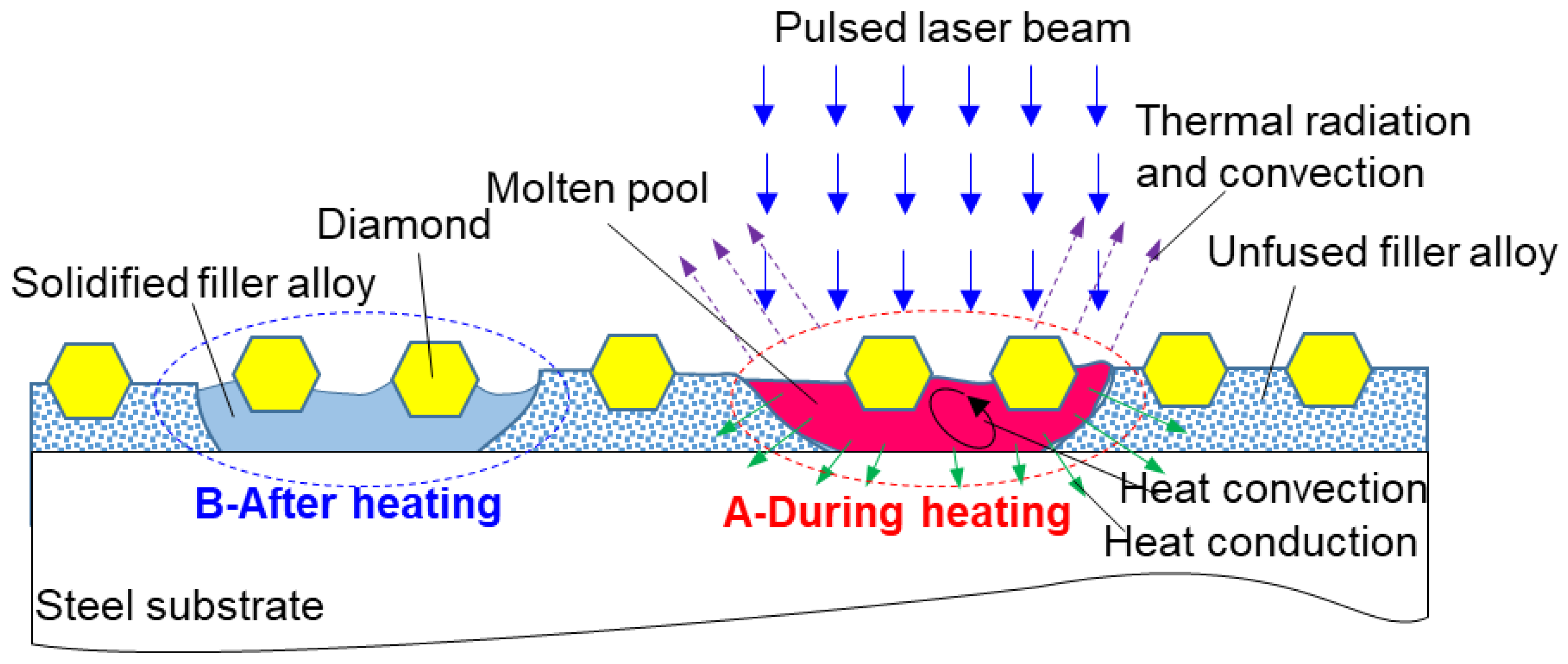
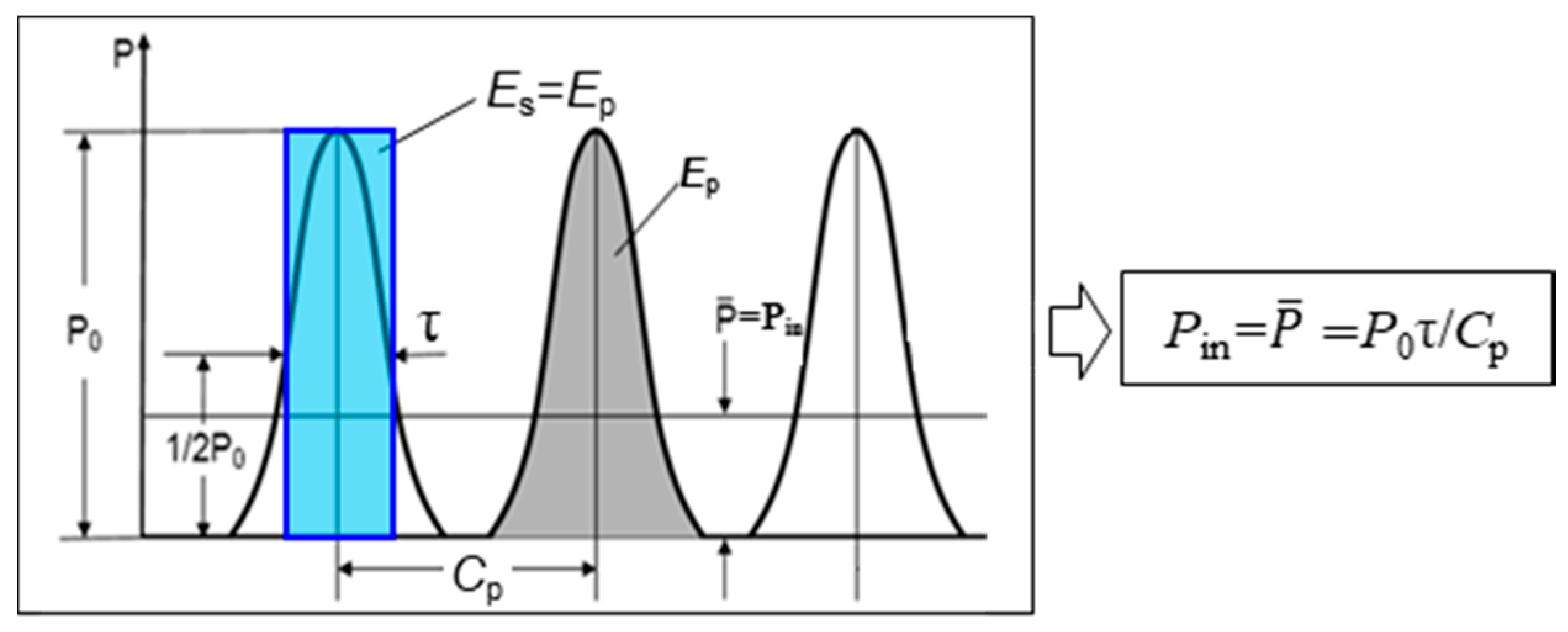
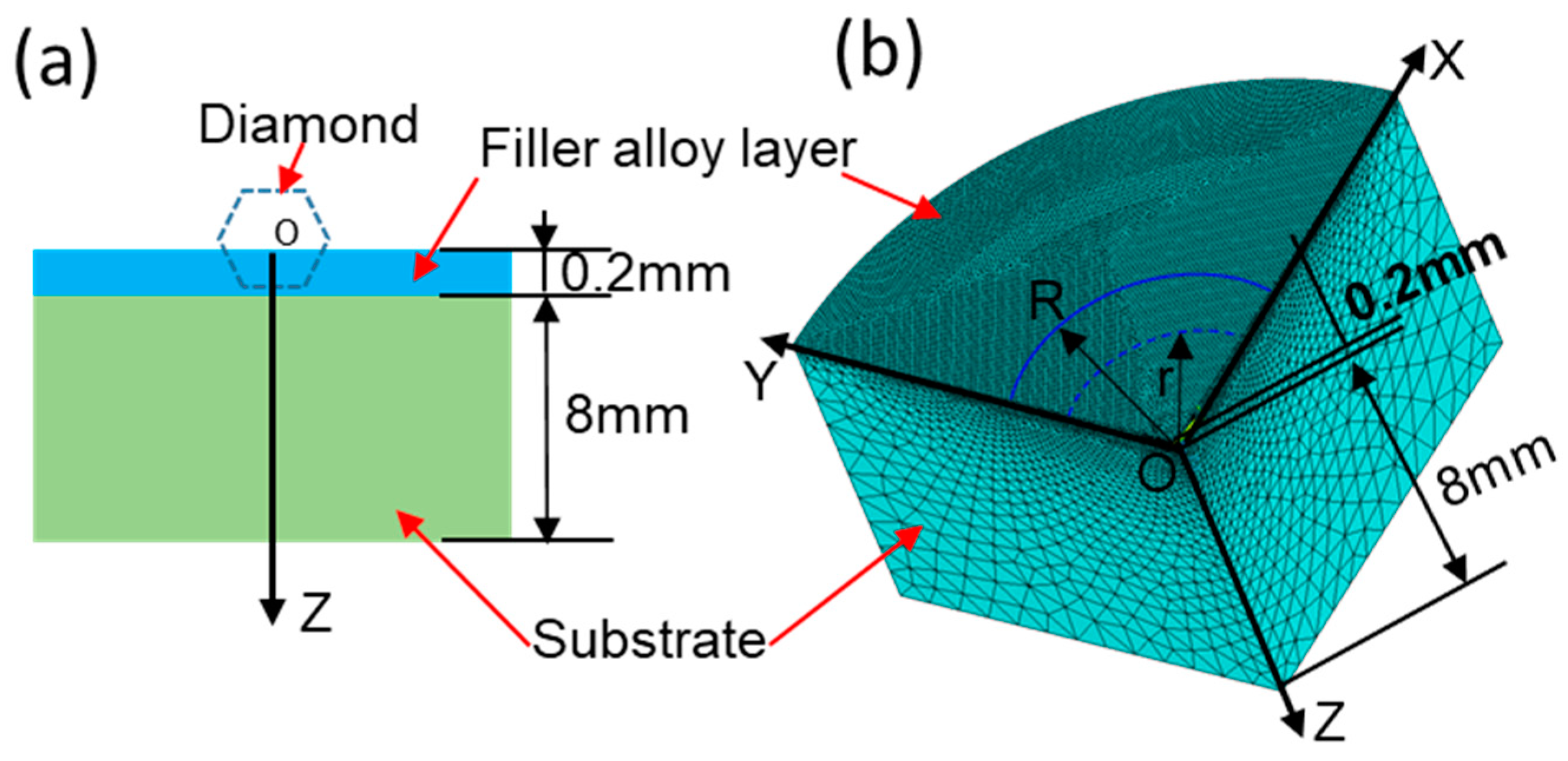
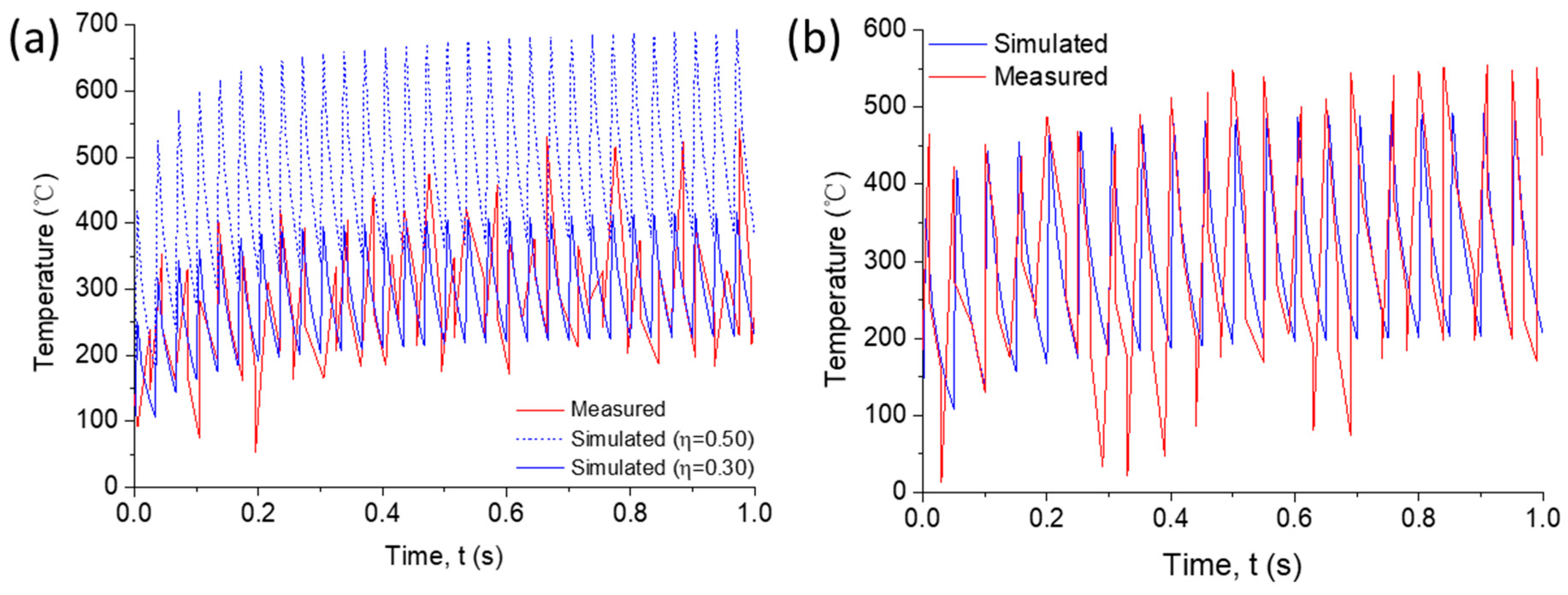
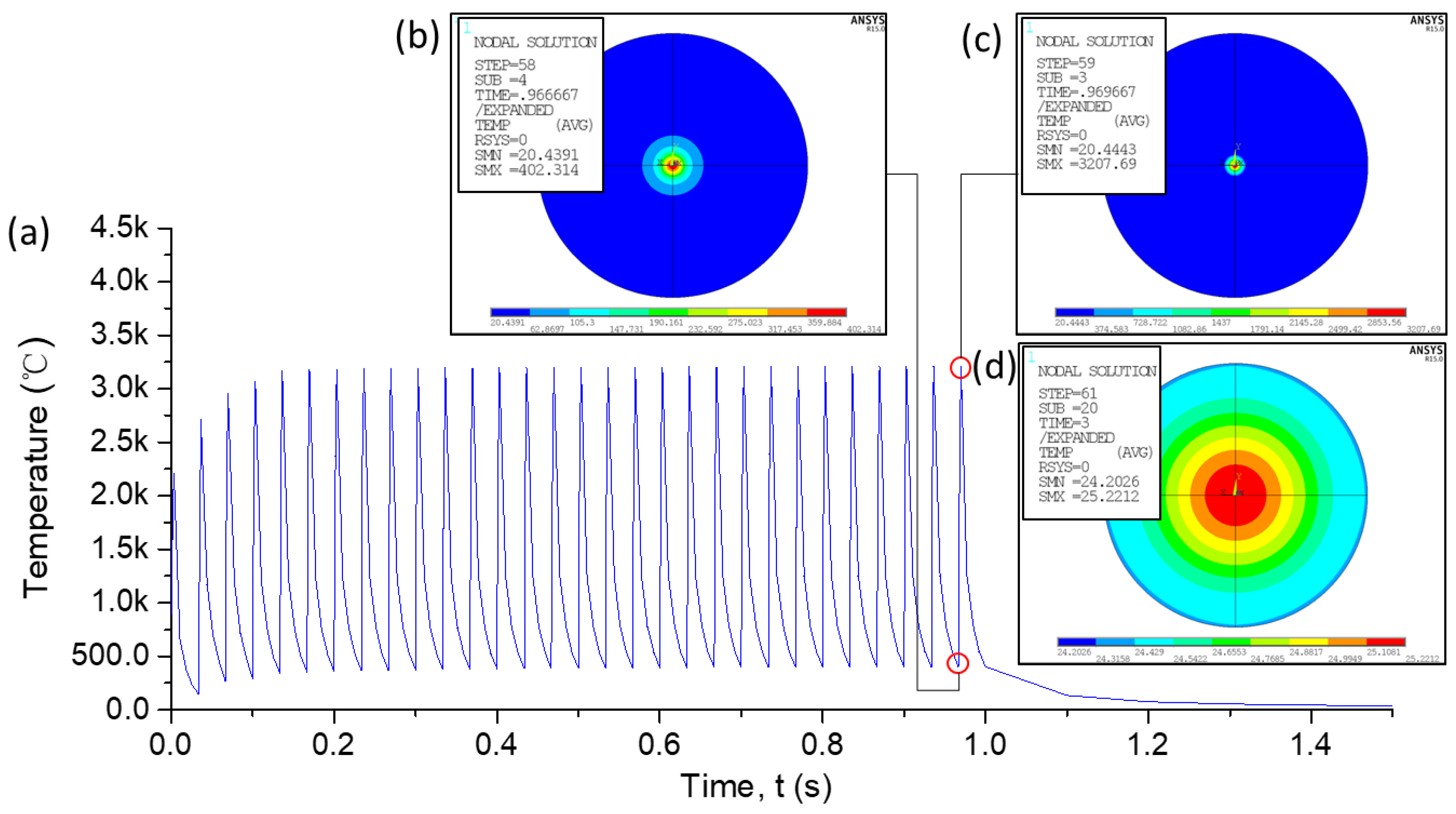
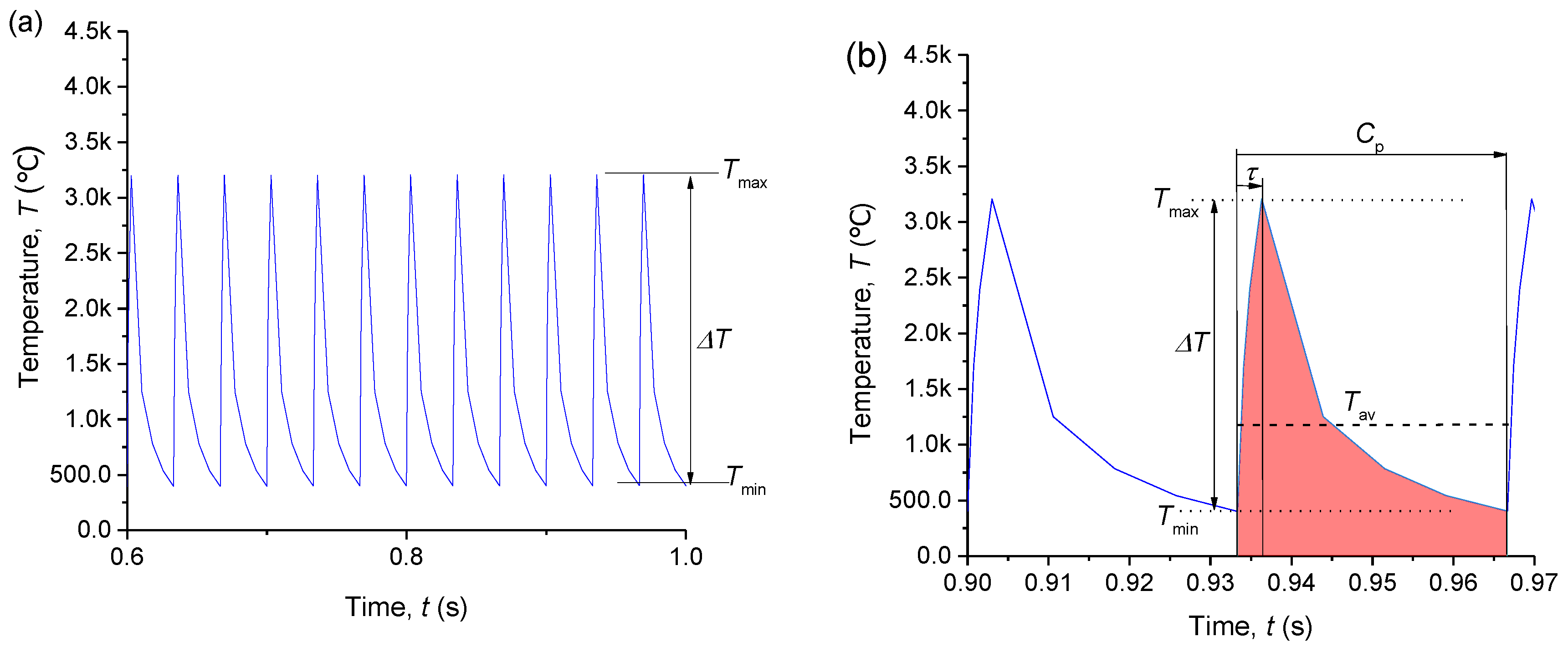
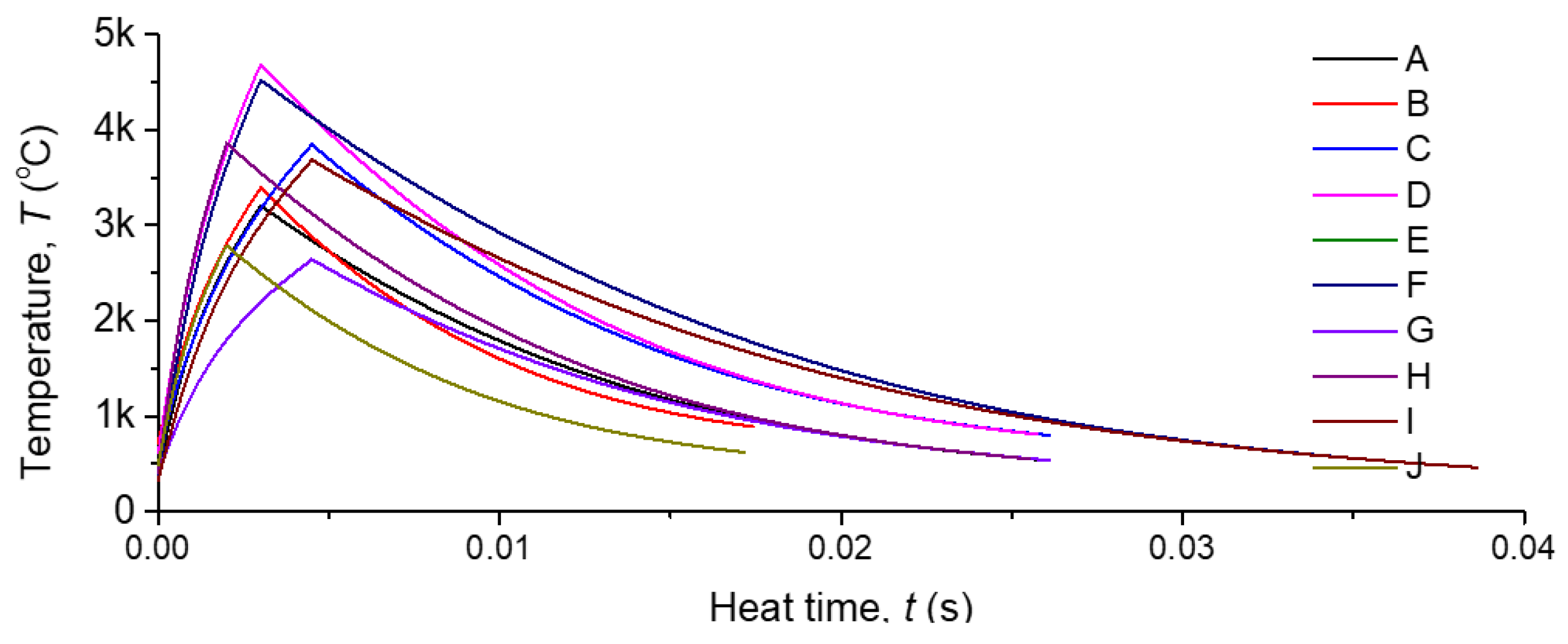

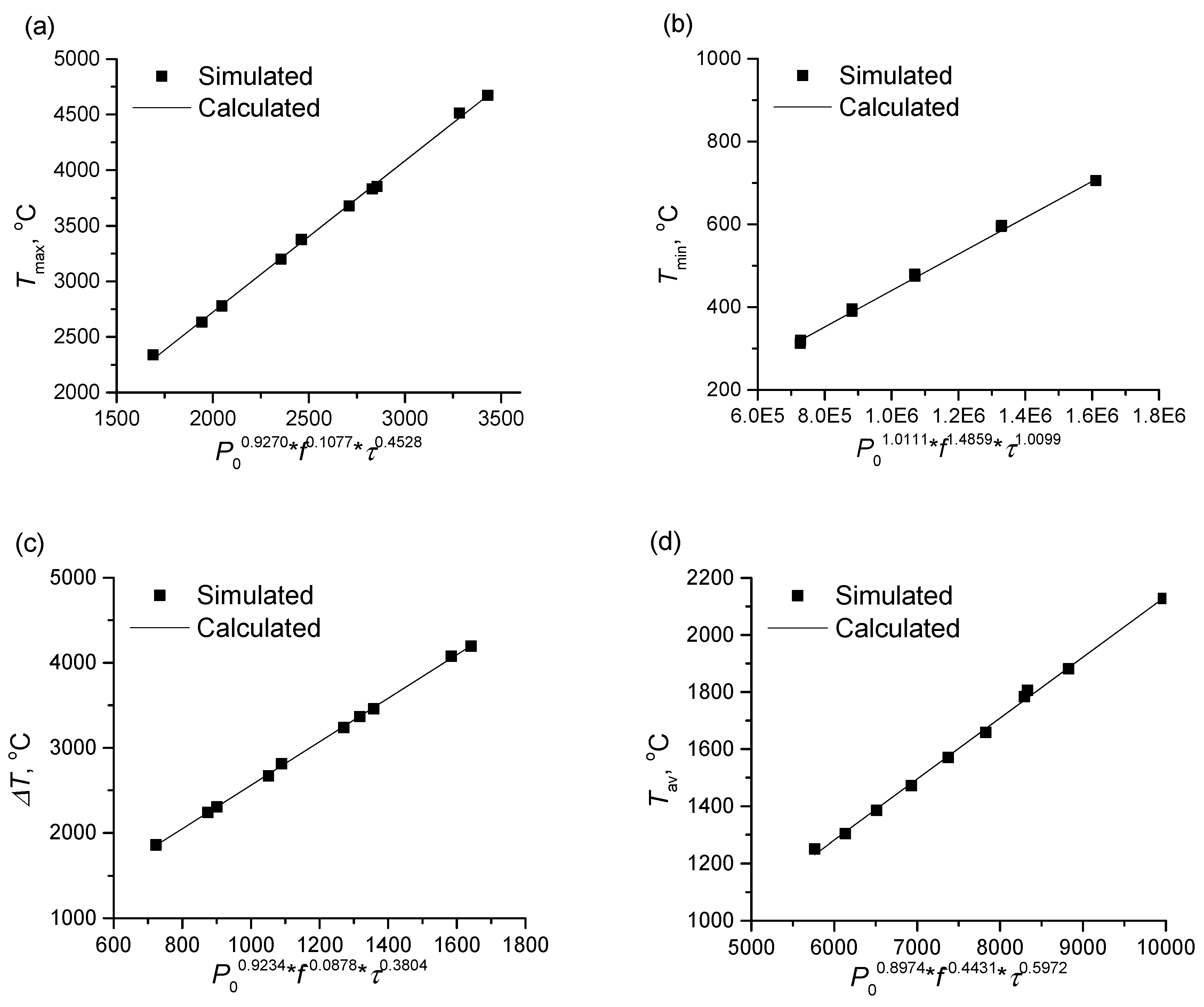
| Simulation Case | Laser Parameters | Temperature (°C) | ||||||
|---|---|---|---|---|---|---|---|---|
| P0 (W) | Pin (W) | f (Hz) | τ (ms) | Tmax | Tmin | ΔT | Tav | |
| A | 1710 | 153 | 30 | 3 | 3200 | 390 | 2810 | 1472 |
| B | 1710 | 230 | 45 | 3 | 3377 | 706 | 2671 | 1784 |
| C | 1710 | 230 | 30 | 4.5 | 3832 | 595 | 3237 | 1881 |
| D | 2565 | 230 | 30 | 3 | 4674 | 597 | 4077 | 2128 |
| E | 1140 | 153.9 | 45 | 3 | 2340 | 480 | 1860 | 1251 |
| F | 2565 | 153.9 | 20 | 3 | 4515 | 320 | 4195 | 1806 |
| G | 1140 | 153.9 | 30 | 4.5 | 2635 | 396 | 2239 | 1304 |
| H | 2565 | 153.9 | 30 | 2 | 3853 | 395 | 3458 | 1659 |
| I | 1710 | 153.9 | 20 | 4.5 | 3678 | 312 | 3366 | 1570 |
| J | 1710 | 153.9 | 45 | 2 | 2779 | 475 | 2304 | 1385 |
© 2019 by the authors. Licensee MDPI, Basel, Switzerland. This article is an open access article distributed under the terms and conditions of the Creative Commons Attribution (CC BY) license (http://creativecommons.org/licenses/by/4.0/).
Share and Cite
Wang, Y.; Huang, G.; Su, Y.; Zhang, M.; Tong, Z.; Cui, C. Numerical Analysis of the Effects of Pulsed Laser Spot Heating Parameters on Brazing of Diamond Tools. Metals 2019, 9, 612. https://doi.org/10.3390/met9050612
Wang Y, Huang G, Su Y, Zhang M, Tong Z, Cui C. Numerical Analysis of the Effects of Pulsed Laser Spot Heating Parameters on Brazing of Diamond Tools. Metals. 2019; 9(5):612. https://doi.org/10.3390/met9050612
Chicago/Turabian StyleWang, Yangguang, Guoqin Huang, Yanfang Su, Meiqin Zhang, Zhen Tong, and Changcai Cui. 2019. "Numerical Analysis of the Effects of Pulsed Laser Spot Heating Parameters on Brazing of Diamond Tools" Metals 9, no. 5: 612. https://doi.org/10.3390/met9050612
APA StyleWang, Y., Huang, G., Su, Y., Zhang, M., Tong, Z., & Cui, C. (2019). Numerical Analysis of the Effects of Pulsed Laser Spot Heating Parameters on Brazing of Diamond Tools. Metals, 9(5), 612. https://doi.org/10.3390/met9050612






